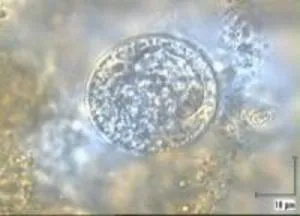Non-destructive Analysis of Biofilms by Raman Microscopy
Objectives
- Development of non-invasive technology for study of the biofilm composition and structure
- Characterisation of extracellular polymeric substances (EPS) in biofilm, elucidation of individual components in EPS
- Analysis of influence of grow conditions on the biofilm composition and structure
Methods of Approach
- Reactor for biofilm grow
- Raman Microspectroscopy
Description
Biofilms present a universal way of microbial life in natural environment. They can grow on nearly every surface in contact with water. Besides cellular constituents, extracellular polymeric substances (EPS) are one major fraction of the biofilm matrix. Confocal laser scanning microscopy (CLSM) offers in situ assessment of the biofilm structure. However, CLSM is not sufficiently specific to differentiate between various polymers (polysaccharides, proteins, nucleic acids and lipids) in a complex EPS matrix. Raman microscopy (RM) allows overcome these limitations and can be used for non-destructive chemical analysis of the biofilm matrix.
The examination of a wide range of reference samples, including biofilm specific polysaccharides, proteins, microorganisms, and encapsulated bacteria, revealed characteristic frequency regions and specific marker bands for different biofilm constituents. The study of different multispecies biofilms revealed that RM can correlate various structural appearances within the EPS matrix to variations in their chemical composition and provide detailed chemical information about a complex biofilm matrix. However, the sensitivity of RM is limited.
Surface-enhanced Raman scattering (SERS), which enables investigations of biomolecules at very low concentration levels, allows overcoming this drawback. We employed colloidal silver nanoparticles for in situ SERS measurements by RM and obtained reproducible SERS spectra from different biofilm constituents. The achieved enhancement factors of several orders of magnitude illustrates a good potential of SERS for sensitive chemical analysis of biofilms, including the detection of different components and the determination of their relative abundance in the complex biofilm matrix (SERS mapping). The results of RM/SERS analysis of biofilms are in good agreement with data obtained by confocal laser scanning microscopy (CLSM). Thus, RM and SERS can be an efficient tool for a label-free analysis of biofilms. Moreover, the combination of RM/SERS with CLSM analysis for the study of biofilms grown under different environmental conditions can provide new insights into the complex structure/function-correlations in biofilms.

Pubilcations
N. P. Ivleva, M. Wagner, A. Szkola, H. Horn, R. Niessner, & C. Haisch, Label-Free in Situ SERS Imaging of Biofilms, The Journal of Physical Chemistry B, 114, 10184, (2010)
N. P. Ivleva, M. Wagner, H. Horn, R. Niessner, & C. Haisch, Raman microscopy and surface-enhanced Raman scattering (SERS) for in situ analysis of biofilms, Journal of Biophotonics 3, 548, (2010)
N. P. Ivleva, M. Wagner, H. Horn, R. Niessner, & C. Haisch, Towards a Non-Destructive Chemical Characterization of Biofilm Matrix by Raman Microscopy, Analytical and Bioanalytical Chemistry 393, 197, (2009)
M. Wagner, N. P. Ivleva, C. Haisch, R. Niessner, & H. Horn, Combined Use of Confocal Laser Scanning Microscopy and Raman Microscopy: Investigations on EPS-Matrix, Water Research 43, 63 (2009)
N. P. Ivleva, M. Wagner, H. Horn, R. Niessner, & C. Haisch, In Situ Surface-Enhanced Raman Scattering Analysis of Biofilm, Analytical Chemistry 80, 8538, (2008)